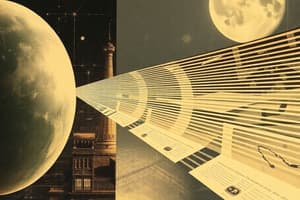Podcast
Questions and Answers
Explain the phenomenon of interference in the context of light waves.
Explain the phenomenon of interference in the context of light waves.
Interference is the redistribution of light energy due to the superposition of light waves from two or more coherent sources.
What are the techniques for obtaining coherent rays for interference?
What are the techniques for obtaining coherent rays for interference?
Coherent rays for interference can be obtained by division of wavefront and division of amplitude.
What are the conditions that need to be fulfilled to observe interference pattern?
What are the conditions that need to be fulfilled to observe interference pattern?
The waves from the two sources must be of the same frequency (i.e. monochromatic) to observe interference pattern.
Provide examples of techniques for obtaining interference.
Provide examples of techniques for obtaining interference.
Describe the method of obtaining interference through division of wavefront.
Describe the method of obtaining interference through division of wavefront.
Flashcards are hidden until you start studying
Study Notes
Interference of Light Waves
- Interference occurs when two or more light waves overlap, resulting in a new wave pattern characterized by regions of constructive and destructive interference.
- Constructive interference happens when waves are in phase, amplifying the amplitude; destructive interference occurs when waves are out of phase, reducing amplitude.
Coherent Rays for Interference
- Coherent light sources emit waves that maintain a constant phase relationship over time, essential for producing stable interference patterns.
- Techniques to obtain coherent rays include using lasers, single-slit diffraction, and Michelson interferometers.
Conditions for Observing Interference Patterns
- The light sources must be coherent, emitting waves of the same frequency and phase relationship.
- The waves must overlap in space and time, allowing for proper interaction.
- The optical path difference between waves must be a multiple of the wavelength for constructive interference or a half-multiple for destructive interference.
Examples of Techniques for Obtaining Interference
- Use of lasers which provide monochromatic, coherent light.
- Young's double-slit experiment highlights the formation of interference patterns due to coherent light passing through two closely spaced slits.
- Newton’s rings experiment demonstrates interference patterns created by the combination of a lens and a flat glass surface.
Division of Wavefront Method
- This method involves splitting a wavefront into two parts, usually by using a beam splitter or a partially reflecting mirror.
- Each part of the wavefront travels different paths before recombining, allowing for the observation of interference patterns based on path length differences.
- This technique forms the basis for many interferometric devices, such as the Michelson interferometer, crucial in precision measurements and applications in physics and engineering.
Studying That Suits You
Use AI to generate personalized quizzes and flashcards to suit your learning preferences.





